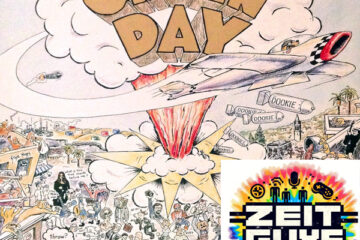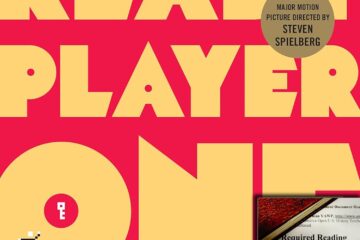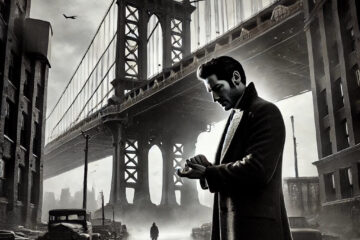The Return of Rip Van Winkle, 1849 by John Quidor
How This Piece Relates to the Story of Rip Van Winkle by Grayson Rogers
This painting, The Return of Rip Van Winkle 1849, by John Quidor resembles the actual story of Rip Van Winkle to near perfection. On a more obvious scale, the painting represents the moment when Rip journeyed back to his town after he had awoken from his 20-year nap. For example, the scene contains Rip himself, Rip’s son sitting on the tree as described in the story, the woman who confirmed the mysterious man to be Rip, and other characters from the actual text. While this is an obvious similarity the painting has to the actual story, there are also more unapparent but just as important details, such as the body language of the characters that help to convey the mood, energy, and confusion that was taking place in this scene, and just how much the world had changed since Rip last left.
One of the main characteristics about Rip that immediately stands out is his desperate and serious approach to this situation. As anyone would be after being asleep for 20 years, Rip is confused about where all the people he knew are, and he does not recognize any of the new buildings around him. Through the desperate look on his face, and the accusatory point of his finger, he is showing just how desperate he is to understand what had just happened. This helps to convey the mood and energy of the situation because it shows how serious and important it was for Rip to find out where he was, where everyone he had once known was, and most importantly what had happened to him.
Similarly, the body language of the man dressed formally on the left shows how skeptical and confused the townspeople were of the man who had just showed up into their town. Not only was he claiming to have been asleep in the woods for 20 years, but he was not recognized by hardly any of the people in the crowd. Just by looking at the facial expressions of the man on the left, this confusion is portrayed. The stern look he is giving to Rip represents how many of the townspeople were not sure whether to believe the story they were being told by this mystery man or not.
Regardless, both main characters in the piece represent emotions felt by all in this scene; an array of confusion, skepticism, and concern for the mystery man and his extreme story of a 20-year nap in the woods.
“Rip Van Winkle” by Pierson Foy
“Rip Van Winkle” by Washington Irving is a story about a man who wanders into the woods and never comes back. While he is walking, he meets some dwarfs playing ninepins. They give him too much to drink, and he falls asleep. When he wakes up, nothing is the same. All of the dwarfs are gone, and he finds his gun corroded. He exits the woods thinking it has only been one day but finds out it has been 20 years. Most of his friends had died off or had become very old. Life had pretty much stayed the same for the rest of the community.
Before he fell asleep, the British were under the rule. When he woke up and went to town, the Americans were independent. Rip Van Winkle fell asleep before 1776 and woke up after 1776. Since he did not age while in his sleep, Rip now knows much more about pre-revolutionary America than anyone else because it happened just the day before. His family has all aged and does not fully recognize him at first. Rip, and his friends always went to the same pub. The name of this pub changed from “King George the Third” to “General Washington.” Irving adds this into the story to show how quickly people’s loyalty can change.
Even people who were not revolutionists still probably went to this bar. This change in the pub’s name alludes to the fact that this story is perhaps an American Tale. Irving is trying to downplay the American Revolution by saying people could have slept through it. Even though the names of things have changed, life for the people in the village is mainly the same. The story tells us that Rip’s son is the same as his father once was. Irving is trying to allude that life continues with or without the revolution.
The Return of Rip Van Winkle by Elisa Umuhire
This oil painting, The Return of Rip Van Winkle, was made by John Quidor in 1849. It is based off of the story, Rip Van Winkle, by Washington Irving in 1820. Rip was the town favorite and a charismatic person to everyone but his wife. Rip is the old man in the middle with a rusty gun by his side and the long white beard. He is in old, ragged clothes. Rip looks like he is scolding the man in front of him, he thought was a town official, because he still assumes that he lives in a British colony under King George. There is a swarm of people around them like a mob with dutch brick houses in the back. A bright American flag is waving up high over the crowd on a flagpole. There is a farmer off to the side who probably is Rip’s son because of his lazy disposition that resembles his father. Rip Van Winkle looks wild because he is looking for his family and the town looks the same but the townspeople are not acknowledging him like they always do, shouting with joy when he walks by. He does not know that he has been asleep for twenty years so he is dumbfounded when he wakes up in the future. At first, he thought his family was captured by the Indians and everyone thought that he went into the woods to shoot himself or he was captured. He drinks ale offered to him by Henry Hudson’s crew from a flagon. There are strong nods to the Romanticism period of art in this painting.
The Romanticism components in this painting show individualism and nature. Individualism with Rip Van Winkle in the center spotlight of the painting and this painting is set in nature with mostly warm colors, orange and brown. He escapes to woods to find refuge and safe haven from his wife, Dame Van Winkle, and this gives a mysterious view to this painting and story. Nature is a powerful force that can be restorative and good so the fact that he went to the woods often to find clarity away from his society is a strong representation of Romanticism.
Painting the Story by Thea Sargent
The image above is an image of Rip Van Winkle returns to his village after falling asleep in a drunken haze twenty years ago. The American Revolution has begun and ended causing Rip to be confused. He tries to tell his, but the politicians do not believe him as shown in the crowd gathered around him. The crowd, however, could be surrounding Rip because he has been assumed dead for twenty years.
Rip’s name literally spells out R.I.P, Rest in Peace. The name an author gives his character shows the narration of that character and R.I.P is a clear connection to the belief that Rip Van Winkle had died. Another reason the crowd may have been depicted as hesitant is because when asked if he was a Loyalist or Revolutionist, he replied with what he thought was the correct answer. The politician, painted as an authority figure in front of Rip Van Winkle, calms the crowd down when he explains that Rip thought loyalty to King George was necessary.
Before the village believes his outlandish story, Rip calls upon his daughter to recognize him. A woman holding a child in the crowd displayed in the painting is inferred to be his daughter. She explains to the village that this crazy old man is her long-lost father. In the painting above, there is a man with a long, gray beard, different clothes, and an individualist light shining upon his figure. These three elements lead the on-looker to believe that the tall, funky looking man in the center of the painting, standing taller than everyone else, is the main character of Rip Van Winkle.
The story of Rip Van Winkle is one of the first pieces of American fiction created. Fiction bloomed in the Era of Romanticism which is shown in the painting as well. The stronger light illuminating the lighter haired, lighter dressed Rip Van Winkle. Individualism was a groundbreaking idea in the Romanticism Era which is displayed through the fantastical ideas, names, and painting of the story of Rip Van Winkle.
The Return of Rip Van Winkle by Kate Hunsberger
Washington Irving writes a well-told tale of Rip Van Winkle, a man who was magically put to sleep asleep in pre-revolution America and wakes up in post-revolution America. The story begins with the contextualization of Van Winkle’s life. Irving describes the harsh life at home for Van Winkle. To cope with the troubles at home, Van Winkle uses the serenity and beauty of the woods. In the woods, Van Winkle comes across a group of Dutch people who give him a bottle forcing him into a deep slumber. Awoken from this slumber, Van Winkle returns to his village, lost and confused about where he is and what happened. In 1849, John Quidor illustrated The Return of Rip Van Winkle in painting form. The image paints the surrounding areas and emotions of Van Winkle and those around him as he returns.
In the background of the painting, Quidor illustrates the Kaatskill mountains or blue highlands,” where Van Winkle ventured out. He puts only a portion of the highlands in the image to show the onward venture of Van Winkle from his old life to his new life. The depiction of
“The Union Hotel” helps guide the change from old to new. Van Winkle describes the hotel as having used to have been a place to “shelter the quiet little Dutch inn.” Next to the hotel stands a banner of General Washington. The importance of this stands as a reminder that we now have a ruling figurehead in our world. Placing this image above Van Winkle shows that he must now adjust to a new way of government through Washington instead of King George. In short, John Quidor uses background images to help demonstrate change and tell the story.
Closer to the image, we can see the stature and emotions of the character displayed in the painting. To begin, Quidor illustrates Van Winkle as torn through his shoes and clothes. Quidor does this to show the change and how time has passed. Like that, Van Winkle holds a run-down gun in his hand, and Irving describes his rifle as a “barrel encrusted with rust, the lock falling off, and the storm warm-eaten.” On the other hand, the emotion of the people surrounding him helps better the understanding of the story. Many characters have confused faces because Van Winkle announces he is “ a loyal subject of the King.” The idea of the King alarmed the Americans because they’d worked so hard to gain this independence from King George. Like the confused faces, the children surrounding him hold edgy looks as they are unsure what to do with Van Winkle. In the beginning, Van Winkle describes the children as running to him with open arms, but now the children are scared and cautious of the newly changed Van Winkle. Overall, Quidor does a superb job of using the painting as an outlet to teach the story that Irving beautifully writes.
Given these points, the story and painting of Rip Van Winkle have maintained great importance in American literature because of their ability to show change from old to new. Not only that but the painting’s ability to express emotion from the lines of a story. The illustration helps the viewers understand these thick lines of writing and push across the point of change in Washington Irving’s Rip Van Winkle story.
The Return of Rip Van Winkle by Chris Haertel
Rip Van Winkle was a man loyal to the crown living in the late seventeen hundreds when he decided to go hunting in the mountains. Everything was going well until he never came back. Rip had fallen into a deep sleep and never woke up, until one day twenty years later. After he had awakened, Rip went back down to his town to find that no one recognized him. Everyone thought that he had died twenty years ago.
The scene being depicted in the painting is of Rip after he had gotten back to town. It is now the eighteen hundreds, America is now its own country. Rip is already dazed and confused,
he is also angry that no one knows who he is, but as a man loyal to the crown he is livid about the American flag flying and the painting of General Washington hanging from the Union Hotel. As all of this happens the people are all still taken aback about who he is and how he is alive.
You can see Van Winkle’s son leaning up against the tree in the left of the painting. Him and Van Winkle are almost dressed the same. Each part of their clothes has rips and almost the same places alluding to the fact that his son is poor and not very well respected in the town.
The background of the painting is displaying romanticism by showing the mountains, which is where he had just come from, in a very open and almost free feeling manner. When we focus back on Rip Van winkle we see him very cluttered and almost trapped by the people around him. In the mountains he was free, but now he is trapped, judged, and feared.
Return of Rip Van Winkle by Liz Gonzalez
The painting Return of Rip Van Winkle by John Quidor illustrates the story of Rip Van Winkle effectively by contrasting Rip and the townspeople by creating a detailed picture. The illustration accomplishes this by incorporating entities of the story. The Return of Rip Van Winkle is the story of a man who lived in pre-revolution America and supposedly fell asleep for twenty years. During his slumber, the colonies gained freedom from the king leaving America completely changed. Rip returns and his city and he himself are changed completely. The details in Rip and the foreground and the background both incite the reader on the story through details. The painting also serves as a wonderful demonstration of romanticism.
One can tell that Rip has changed because he appears older. He showcases a lengthy, white beard. He is dressed plainly and in traditional colonial dress. His clothes look torn. The color of his clothes is pale compared to the townspeople’s red, white, and blue. And, he appears to be accusing people in the town by pointing fingers giving the reader the impression that he feels greatly confused. And, finally, the rusty rifle he carries was mentioned in the story to compliment Rips aging with the aging of the gun.
Secondly, the background also hints at aspects of the story. A small dog is painted to be reminiscent of Wolf Rip’s old dog. Washington, the new president, is pictured above the pub. The hotel is labeled the union hotel in reference to united America. The stepped roof of the houses hint to the setting being New York and the part of New York influenced by the dutch. The pole holds an American Flag. And, the mountains from which he arose from his slumber are pictured.
The details in this painting help the reader understand and grasp small details of the story with elements of romanticism. Romanticism is a type of art that showcases the individual. In this painting there are a few individuals. One being Rip Van Winkle and the other being America. America is an important individual because the country finally has freedom from its father.


